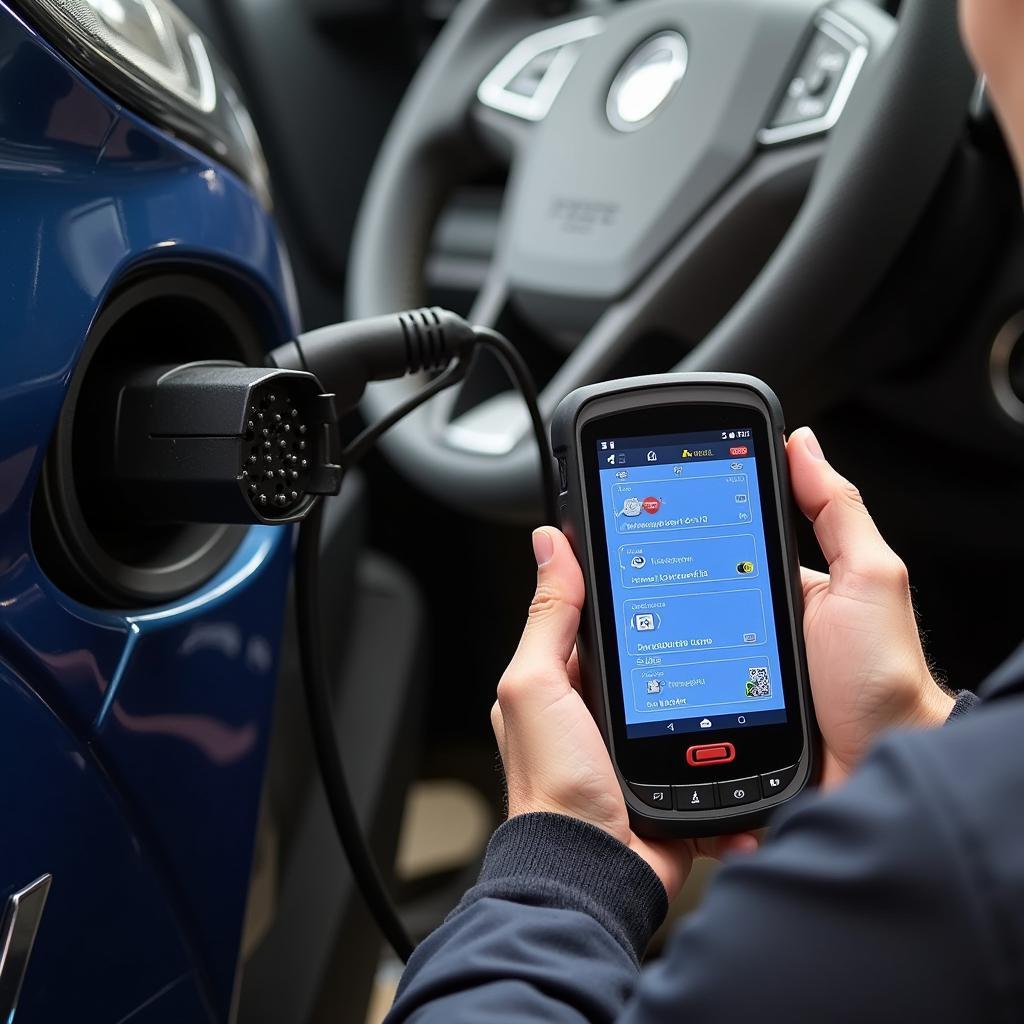A diagnostic test on a car is a crucial process used to identify potential problems within a vehicle’s various systems. From engine performance to transmission issues and even the smallest electrical glitches, a diagnostic test uses specialized equipment to pinpoint the source of the trouble, saving you time and money on unnecessary repairs. Understanding what a diagnostic test entails can empower you to make informed decisions about your car’s maintenance and repairs.
Understanding the Importance of Car Diagnostic Tests
Car diagnostic tests are essential for maintaining the health and longevity of your vehicle. They provide a detailed snapshot of your car’s internal workings, allowing mechanics to quickly and accurately diagnose problems that might otherwise be difficult to detect. Regular diagnostic tests can also help prevent minor issues from escalating into major, costly repairs. Think of it as a check-up for your car, ensuring everything is running smoothly.
How Does a Car Diagnostic Test Work?
The process involves connecting a specialized scan tool, often referred to as an OBD-II scanner, to your car’s onboard diagnostic port. This port, typically located under the dashboard on the driver’s side, acts as a communication gateway to the vehicle’s computer system. The scanner retrieves diagnostic trouble codes (DTCs) stored in the car’s computer, which are essentially error messages indicating specific malfunctions. These codes are then interpreted by the mechanic to pinpoint the problem area.
What Can a Diagnostic Test Detect?
A diagnostic test can reveal a wide range of issues, including problems with the engine, transmission, brakes, exhaust system, airbags, and other electronic components. It can detect faults in sensors, actuators, and other vital parts of the vehicle’s systems. For instance, a diagnostic test might identify a faulty oxygen sensor, a misfiring cylinder, or a problem with the transmission control module.
Different Types of Car Diagnostic Tests
While the OBD-II scan is the most common type of car diagnostic test, there are other specialized tests that can be performed depending on the nature of the problem. These include:
- Visual Inspection: A trained mechanic will visually examine various components of the vehicle, looking for signs of wear and tear, leaks, or damage.
- Mechanical Tests: These tests assess the functionality of mechanical parts like the engine, transmission, and brakes, often involving specialized tools and equipment.
- Electrical Tests: These tests use multimeters and other electronic diagnostic tools to check the integrity of wiring, circuits, and electrical components.
Why is a Diagnostic Test Important for Car Repair?
Diagnostic tests provide a systematic approach to troubleshooting car problems. They eliminate guesswork and ensure that repairs are targeted and effective. This saves you money by preventing unnecessary replacement of parts and reduces the time your car spends in the shop.
When Should You Get a Car Diagnostic Test?
It’s recommended to get a diagnostic test if your car exhibits unusual symptoms, such as warning lights on the dashboard, strange noises, or performance issues. Regular diagnostic tests as part of your car’s preventative maintenance schedule can also help identify potential problems before they become major headaches.
What to Expect During a Diagnostic Test
The process typically involves a mechanic connecting the scan tool to your car’s diagnostic port and retrieving the stored trouble codes. The mechanic will then interpret these codes and perform further tests if necessary to pinpoint the exact problem. You should expect a detailed explanation of the findings and a recommended course of action.
“Regular diagnostic tests are like preventative medicine for your car,” says John Smith, a seasoned automotive technician with over 20 years of experience. “They can save you a lot of money in the long run by catching small problems before they become big ones.”
Conclusion
A diagnostic test on a car is a vital tool for identifying and resolving vehicle issues efficiently. It helps prevent costly repairs, ensures the proper functioning of your vehicle, and provides peace of mind knowing your car is in optimal condition. Regular diagnostic tests are a smart investment in your car’s health and longevity.
FAQs
- How much does a car diagnostic test cost? The cost varies depending on the complexity of the test and the shop’s labor rates.
- Can I perform a diagnostic test myself? Yes, with an OBD-II scanner and some basic knowledge, you can read the codes yourself, but interpreting them accurately may require professional expertise.
- How often should I get a diagnostic test? It’s recommended to get a diagnostic test annually or whenever your car exhibits unusual symptoms.
- What is an OBD-II port? It’s the standardized port used to connect a scan tool to access a vehicle’s computer system.
- What are DTCs? Diagnostic Trouble Codes are error messages stored in the car’s computer, indicating specific malfunctions.
- Will a diagnostic test fix my car? No, the test identifies the problem; repairs are then needed to fix it.
- Can a diagnostic test be wrong? While rare, misdiagnoses can occur, usually due to faulty sensors or incorrect interpretation of the codes.
Common Scenarios Requiring a Diagnostic Test:
- Check Engine Light illuminated
- Unusual engine noises
- Poor fuel economy
- Transmission problems
- Brake issues
- Airbag warning light
Further Reading:
- Understanding Car Maintenance Schedules
- Choosing the Right Mechanic for Your Car
- The Importance of Regular Oil Changes
Need assistance? Contact us via WhatsApp: +1(641)206-8880, Email: [email protected]. We have a 24/7 customer support team ready to help.


